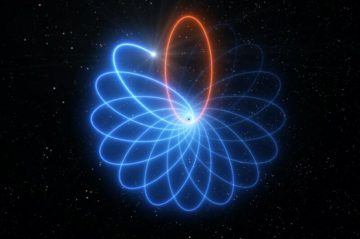Jennifer Ouellette in Ars Technica:
 It’s been nearly 30 years in the making, but scientists with the Very Large Telescope (VLT) collaboration in the Atacama Desert in Chile have now measured, for the very first time, the unique orbit of a star orbiting the supermassive black hole believed to lie at the center of our Milky Way galaxy. The path of the star (known as S2) traces a distinctive rosette-shaped pattern (similar to a spirograph), in keeping with one of the central predictions of Albert Einstein’s general theory of relativity. The international collaboration described their results in a new paper in the journal Astronomy and Astrophysics.
It’s been nearly 30 years in the making, but scientists with the Very Large Telescope (VLT) collaboration in the Atacama Desert in Chile have now measured, for the very first time, the unique orbit of a star orbiting the supermassive black hole believed to lie at the center of our Milky Way galaxy. The path of the star (known as S2) traces a distinctive rosette-shaped pattern (similar to a spirograph), in keeping with one of the central predictions of Albert Einstein’s general theory of relativity. The international collaboration described their results in a new paper in the journal Astronomy and Astrophysics.
“General relativity predicts that bound orbits of one object around another are not closed, as in Newtonian gravity, but precess forwards in the plane of motion,” said Reinhard Genzel, director at the Max Planck Institute for Extraterrestrial Physics (MPE) in Garching, Germany. “This famous effect—first seen in the orbit of the planet Mercury around the Sun—was the first evidence in favor of general relativity. One hundred years later we have now detected the same effect in the motion of a star orbiting the compact radio source Sagittarius A* (SagA*) at the center of the Milky Way.”
When Einstein developed his general theory of relativity, he proposed three classical tests to confirm its validity.
More here.
